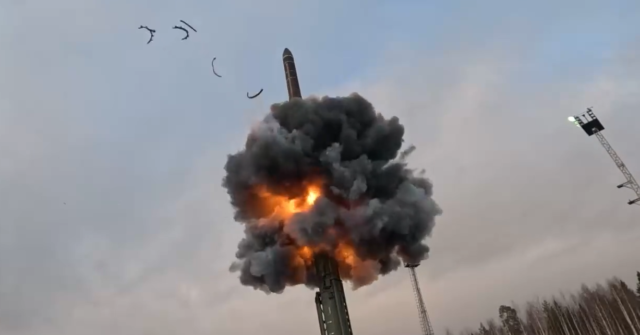We support our Publishers and Content Creators. You can view this story on their website by CLICKING HERE.

Russia has allegedly launched an Intercontinental Ballistic Missile (ICBM) at a Ukrainian city for the first time, an expensive but potentially potent reminder by the Kremlin that it has a large reserve of nuclear-capable weapons which can strike form thousands of miles away.
The central-Ukrainian city of Dnipro was struck by a single ICBM missile in the early hours of Thursday morning Ukraine claims, part of a broader air raid that state media said also saw one air-launched ballistic missile and seven air-launched cruise missiles fired at the city. The Ukrainian government has not made an official statement on casualties in the “massive attack” but said they managed to shoot down six of the cruise missiles in-flight.
The launch of an ICBM is claimed by Ukraine’s air force to have come from the Astrakhan Oblast, which borders the Caspian Sea. The launch has not been corroborated by Western states observing the conflict, the United Kingdom has called it unconfirmed, for instance. Russia has yet to confirm or deny an conventional explosive armed but nuclear-capable ICBM launch, apparently the latest sabre-rattling move by the state as it bids to discourage further Western involvement in Ukraine.
While claiming there was “no significant damage” caused, nevertheless Ukraine also stated a city medical facility and an industrial area were hit. Sergiy Lysak, the head of the regional administration said in a statement that: “Since early morning, the aggressor has massively attacked the region. Information about the consequences is being clarified. At the moment, it is known about damage to an industrial enterprise in Dnipro. There were also two fires in the city.”
Ukraine called the attack an attempt to damage the city’s “critical infrastructure” . Meanwhile, just 70 miles away a power interconnector for the Zaporizhzhia Nuclear Power Plant was cut in an air strike. This left the plant with just one backup power supply.
A loss of external power can be catastrophic for a nuclear plant because the control systems that govern the reaction process — and which can crash-stop it in an emergency — cannot safely rely on the power the plant itself produces and need redundancy. The Zaporizhzhia plant has been occupied by Russian forces for several years and is presently run by Russian nuclear company Rosatom, one of the few Russian businesses that has been untouched by Western sanctions as Russia is a massive global player in the supply of Uranium, needed by nuclear power plants everywhere.
Russia has neither confirmed nor denied the alleged ICBM launch at time of press. At a morning briefing, top Kremlin spokesman Dmitry Peskov merely said “I have nothing to say on this topic right now”. If true, the strike — the first of its kind in this conflict — comes amid a period of rapidly climbing tensions between Russia and the Western backers of Ukraine.
The United States relented on President Biden’s long-held position that allowing Ukraine to launch long-range missile strikes into Russia itself would be a potentially dangerous escalation of the conflict late last week, the first such strike occurring on Tuesday. Further strikes, using both American and British made precision missiles followed into Wednesday.
Russia has stated that it considers precision attacks against military or political targets inside the Russian Federation an act of war by the states providing the weapons, even if they are launched by a third party. How far Russia is willing to take this nuclear sabre-rattling is unclear: at several points through this conflict the Kremlin has expressed its displeasure at Western nations involving themselves in what it clearly considers a private war but never followed through with threats on issues like the supply of tanks, earlier missiles, and jet fighters.
Yet long-range missile strikes inside Russia may be taken a lot more seriously inside the Kremlin. Talks about the policy of whether to give Ukraine permission to engage in such attacks against their invader have gone back months, and key moments have been met with Russian reminders that they ultimately hold a trump card against attempts to bring down the Putin state.
When Zelensky was in Washington in September to ask for long-range strikes, Russia appeared to respond by saying it was reviving its nuclear doctrine to create a state of co-responsibility for attacks by American-backed states. In October Russia issued what very much looked like a reminder of what it holds in reserve and had never yet deployed in anger, a considerable armoury of Intercontinental Ballistic Missiles, conducting continent-spanning test-firings.
A land-launch of a Yars ICBM from Plesetsk to Archangesk (pictured, top) demonstrated a range of 3,500 miles, with Russia publishing quantities of footage showing the launch of several nuclear-capable missiles. The Yars is Russia’s newest ICBM, part of the development of their first such new weapon since the end of the Cold War, with the 3,500 mile flight only around half of its claimed maximum range, designed to strike deep into the United States if required.
Then earlier this week, as the U.S. was stated to have signed off on strikes on the Russian interior with American-made missiles in Ukrainian hands, Vladimir Putin signed off on that new nuclear doctrine, a further message to the West.
While today’s alleged launch and strike serves a warfare rather than training purpose, the use of an ICBM to deliver a conventional warhead rather than a considerably cheaper and less sophisticated tactical ballistic or cruise missile is a pointed further message from Russia to the West.
Poland, one of the European states closest to the fighting and perhaps taking the most alarmist state about Russian territorial ambitions — it is practically a matter of faith in Polish defence circles that Moscow has designs on Poland, should it succeed in Ukraine — appears to have reacted to the Thursday morning launch, scrambling fighters and and land-based defence systems.
A statement from the Polish Air Force, which operates F-16 jets, said Thursday: “Attention, due to another attack by the Russian Federation, which is carrying out strikes on objects located, among others, in western Ukraine, Polish and allied aircraft have begun operating in our airspace… the Operational Commander of the RSZ activated all available forces and resources at his disposal, the on-duty fighter pairs were scrambled, and the ground-based air defence and radar reconnaissance systems reached the highest state of readiness.”

 Conservative
Conservative  Search
Search Trending
Trending Current News
Current News 







